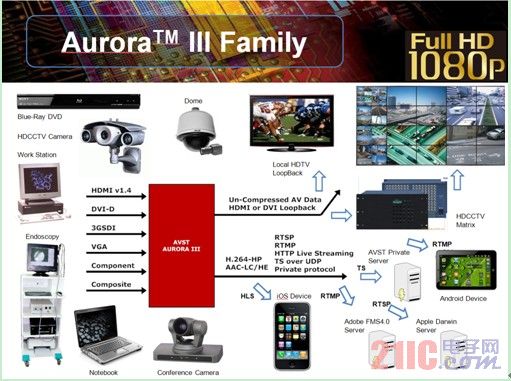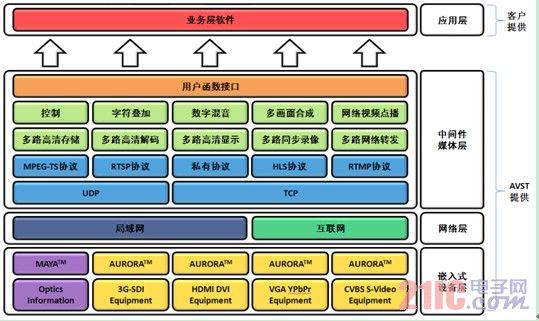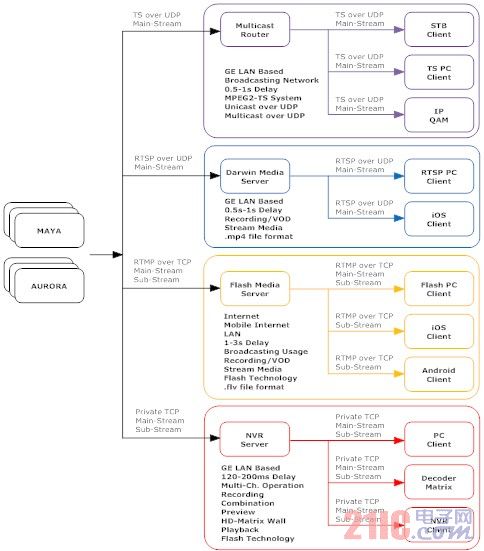Video encoder new technology development trend
ã€Market analysis】 The LAN-based SD video system evolved in two directions, one is the LAN high-definition video system, and the other is the Internet and mobile Internet standard definition video system, which requires a new generation of video systems must balance high-definition resolution, support more Streaming and multi-protocol support for live, on-demand, on-demand applications across LAN, Internet and mobile internet. Web-based real-time video applications have been active in the traditional vertical industry market, and online video is an old but challenging technology area: The video surveillance system was born to meet the video information of multiple remote locations. Through the network camera, storage server and forwarding server, a typical video surveillance system can be constructed. Through the video wall of the client or monitoring center, View video information of multiple remote spaces, used in emergency command, security monitoring, intelligent transportation and other occasions; The above three typical systems abstract the model: look at one point, look at multiple points, and see more points. In order to meet the technical needs of these three basic models and the technical needs of the Internet, a device is needed. It can be applied to both existing systems and Internet applications, so that the integrator's existing services can be upgraded to high-definition video using proprietary protocols on the private network, and can be fully and quickly advanced to the Internet using Flash streaming media technology. The market, based on Aowei Video's latest third-generation embedded processor system framework technology, the AURORA series network encoder products and the MAYA series network camera products are the only embedded coding devices on the market that support multi-mode protocols. The design concept is to provide integrator users with three dimensions of unification: The first is the unification of the high-definition video resolution dimension, which is aimed at the difference between the SD video system and the HD video system and the private network and Internet bandwidth resources. Vivid's 1080P HD products are available in resolutions from 320 x 240 to 1920 x 1080 From 10 frames per second to 60 frames per second, the code rate supports from 100kbps up to 20Mbps. The video uses the most advanced and efficient H.264 High Profile compression algorithm. The audio uses two-channel stereo AAC or MP3 compression. The algorithm can greatly save bandwidth and improve the subjective quality of audio and video. The second is the unification of digital-analog interfaces. At present, the number of analog source devices in the market is still huge, and high-definition video uses digital interfaces, interlaced video and Progressive video still coexists, which will inevitably require integrators and end users to purchase multiple encoding devices for different sources to access the network, while Avitech's AUR3G7KE series products target this multi-standard digital model. The coexistence of the interface gives a perfect answer, which allows the user system to support analog composite video (CVBS and SVideo), analog component video (Component), VGA analog graphics interface (RGBHV), DVI- with zero changes. D digital graphics interface, HDMI multimedia high-definition digital interface and access to multiple signal sources including SDI/HDSDI/3GSDI high-definition serial digital interface Greatly protect the customer's investment, and help integrators to meet the needs of end users and systems with the fastest speed and zero replacement cost; the third is the unification of multi-mode access protocols, Aowei video equipment can support four at the same time Access protocols, including TS transport stream protocol, RTSP real-time streaming media transport protocol, Flash RTMP protocol and AVST proprietary protocol, wherein the proprietary protocol is applicable to vertical industry integrators' existing recording and broadcasting platform software, and AVST provides for private protocols. Complete PC-side SDK development kit and technical support services, SDK development kit supports high-efficiency 1080P60 decoding and display library, support for network preview, storage, playback, forwarding and other core media layer functions; TS transport stream protocol is mostly used for broadcasting and television System platform, STB system-based information publishing platform and various live broadcast systems; RTSP real-time streaming media transfer protocol is mostly used for private network systems based on Apple's Darwin streaming media server or Apple's various terminal devices such as iPhone, iPad and MAC computer; RTMP real-time information protocol is the core part, Aowei video company is embedded The Flash Media Server software protocol stack was successfully developed on the system, which allows users to directly view the device's Flash video directly without a plug-in using a browser that supports Flash. The encoding device also supports direct push of Flash audio and video streams to the Flash stream. Media servers, including Adobe's FMS server, open source version of Red5 server and commercial WOWZA server. This article refers to the address: http:// [Encoder Features] AUR3G7KE is the main product of Aowei AURORA's third-generation encoder product line. AUR3G7KE adopts intelligent interface technology. The device supports power-on automatic identification of input signal format. At the same time, the device can track and synchronize the input signal at the same time. That is, if the signal detected by the device is 1080P60 when the power is turned on, when the code transmission is performed, the signal source becomes 720P60, and the encoder can automatically detect the change of the signal source without any restart or manual intervention, and correspondingly The adjustment, the network transmission until the format and resolution of the decoding display will be changed synchronously, greatly improving user experience and system intelligence. AUR3G7KE supports four-mode network transmission protocol, providing customers with complete SDK and protocol documentation. It can support standard RTSP protocol, RTMP protocol, TS protocol and private protocol. It is worth mentioning that when using proprietary protocol, the encoder Working in 1080P30/P60 mode, the system's end-to-end delay is only 110-120ms, which can fully achieve strong real-time effects. The AUR3G7KE product line supports innovative windowing video processing technologies, including hardware scaling, deinterlacing (interleaving), frame rate conversion (upconversion and downconversion), resolution and frame rate conversion techniques that can handle 576i The /480i/1080i interlaced video to progressive function converts low-definition video images into high-definition progressive video images. The window-opening technology allows users to customize a variety of non-standard video image formats. AUR3G7KE adopts a variety of advanced image processing technologies, including multiple target area coding techniques (Multi-ROI-Coding), which can perform priority quality coding for multiple regions of interest set by users. Under the premise, the image quality of the ROI area is greatly improved; at the same time, the product also supports adaptive scene switching, and parameters are optimized for various typical user scenarios, so that AUR3G7KE is in movie mode, desktop mode, text mode, Typical application scenarios such as endoscope mode, recording mode, live mode, conference mode, and monitoring mode all show optimal performance. AUR3G7KE supports full HD real-time dual stream output. It can support H.264-HP standard of 720x576p25 in secondary stream while the main stream supports 1920x1080p25 H.264-HP standard, and the primary and secondary streams can independently set the bit rate. And H.264 encoding grade (BP/MP/HP) and network transmission protocol, the typical application can use RTSP protocol or proprietary protocol in the local area network (special network) with 1080P full HD main stream to work at 4-8Mbps rate In the Internet (public network) using RTMP protocol with 720x576p25/320x240p30 sub-stream to work at 200-500kbps code rate, to meet the "local area to see clear, the Internet to see" market demand. [System Integration Case] Avitech's third-generation embedded processor system framework software development kit (AVSolution Technology Co., Ltd. Embedded-Processor-System-Framework III, hereinafter referred to as SDK3.0) is a set of high-performance multimedia middleware based on IP network. Software, based on Ovi's third-generation embedded processor system framework technology, SDK3.0 can support all of Ovid Video's EPSF-III series of embedded products, including the AURORA series of embedded HD encoders, MAYA series network HD cameras, CERES series of HD decoders and servers, the goal is to build a full-HD audio and video system based on IP across LAN and Internet. AVST's embedded devices include two product lines, AURORA HD encoder and MAYA HD network camera, including multi-stream multi-protocol applications, SDK 3.0 for the standard development of the interconnection protocol MPEG-TS protocol, RTSP protocol, RTMP protocol The device control interface calling routine is used for system integration using an existing system or an open source/commercial streaming media server, such as using MPEG-TS protocol and multicast function to realize television signal monitoring of radio and television systems, and realizing remote multimedia information distribution. Such as the use of RTSP protocol and Darwin server to achieve digital court and remote interrogation system integration, such as using RTMP protocol and FMS4.5 or Red5 server to achieve Internet live broadcast and mobile Internet live broadcast system integration; for Ovid video's proprietary high-performance interconnect protocol provides complete The multimedia middleware software can quickly develop or deploy recording, live broadcast, on-demand server, forwarding server, client and digital matrix to support multi-screen HD TV wall display. ã€to sum up】 Mr. Zheng Xiaolong, Marketing Development Manager of Texas Instruments, said: "Texas Instruments (TI) is committed to providing customers with superior solutions to help them cope with various design challenges. We are very happy to see Ovi Video adopt TI's DaVinci technology introduces a series of IP-based 1080P HD video products and system-level solutions, which can help integrators and engineers quickly complete system integration and system deployment. In the future, TI and Ovid will continue to deepen. The cooperation, I believe that TI's powerful video processor platform can bring greater success to Ovid Video and more innovative breakthroughs in the digital video processing industry." Mr. Wang Fuyu, general manager of Ovi Video, said: “Information technology can reduce the cost of communication between people and reduce the cost of acquiring unknown information. As long as it is a technology that can reduce the cost of communication or the cost of acquiring unknown information, it can always be successfully transformed. For the product, to form a new market, to promote the development of productivity and the progress of human civilization. The transformation of the industrial chain is inevitable, both in the consumer market and the industry market, and the emerging Internet video technology is rapidly integrating with the traditional industry market. Aowei Video focuses on the R&D and accumulation of core technologies for high-performance video products. It can provide high-quality network video products and system products for integrators and engineering customers in many vertical industries. We are willing to work closely with our customers to open them together. A new chapter in the digital video market." Dongguan Fangbei Electronic Co.,Ltd , https://www.connectorfb.com
The Internet has completely changed people's lives and communication methods. From Web1.0 to Web2.0 to search engines, people can first obtain text and image information through the Internet. In recent years, video file information can also be obtained through the Internet and Others share their uploaded video clips, such as Tudou, Youku, etc. It is foreseeable that in the near future, accessing online real-time video information via the Internet or publishing shared online real-time video information will become a new market growth point.
The video conferencing system was born to meet the multi-point full-duplex video communication. The video conferencing camera, the video conferencing terminal and the multi-point access unit constitute a multi-point video duplex communication system. People can use a dedicated system and a dedicated network to off-site. Convening meetings, the emergence of such a system can shorten the cost of people going to meetings in different places, reduce the frequency of travel, and shorten the decision-making time. Such as Polycom's video conferencing system, Cisco's telepresence system belongs to this type of system;
The video recording and broadcasting system is designed to meet the needs of multiple users watching one or several video sources at the same time. The camera, recording server and client can construct a typical video recording and broadcasting system, multiple clients. You can log in to the recording server to watch online video or on-demand video. This system is mainly used in recording and broadcasting classrooms in the education industry, digital operating rooms in the medical industry, and digital court trials in the public security industry. 
Figure-1 Typical application of HD video encoder 
Figure-2 SDK3.0 middleware software composition 
Figure-3 Typical system integration of SDK3.0 middleware software